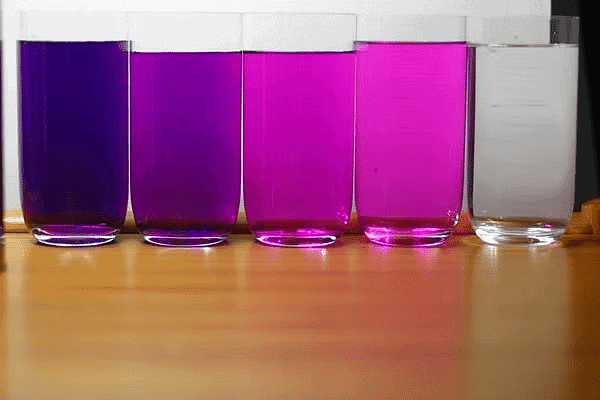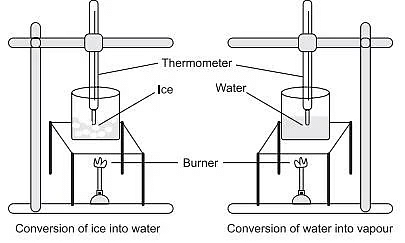Matter in our surroundings Class 9 Notes Science Chapter 1
| Table of contents |

|
| Physical Nature of Matter |

|
| Characteristics of Particles of Matter |

|
| States of Matter |

|
| Can Matter Change Its State? |

|
| Evaporation |

|
When we observe our surroundings, we notice a vast array of objects, each differing in shape, size, and texture. Despite these differences, all these objects share a fundamental characteristic: they are made up of matter. But what exactly is the matter?
Matter is defined as anything that occupies space and has mass. It is the substance that constitutes the entire universe, from the smallest grain of sand to the largest star in the sky.
 Everything around us, including the air we breathe, the food we eat, stones, clouds, stars, plants, animals, and even a tiny drop of water or a grain of sand—everything is matter.
Everything around us, including the air we breathe, the food we eat, stones, clouds, stars, plants, animals, and even a tiny drop of water or a grain of sand—everything is matter.- Universal Presence: Everything, from solids to gases, is made of matter.
- Historical Context: Ancient Indian philosophers identified matter as five basic elements: air, earth, fire, sky, and water, known as the 'Panch Tatva'.
- Focus of the Chapter: This chapter explores the physical properties of matter and its various states—solid, liquid, and gas.
By understanding these concepts, you'll gain insight into the material world that surrounds us.
Physical Nature of Matter
The physical nature of matter refers to its fundamental properties and behaviour, as observed and studied through scientific inquiry. The main properties of matter are:
1. Matter is made up of Particles
Matter is made up of particles. These particles can be atoms, molecules, or ions, depending on the specific substance.
The particle nature of matter can be demonstrated by a simple activity.
Experiment:
(i) Take about 50 ml of water in a 100 ml beaker.
(ii) Mark the level of water.
(iii) Add some salt to the beaker and stir with the help of a glass rod.
(iv) Observe the change in water level.Observation:
(i) It is observed that the crystals of salt disappear.
(ii) The level of water remains unchanged.Explanation:
A water molecule consists of hydrogen and oxygen atoms; between hydrogen and oxygen, there are large empty spaces. These empty spaces are known as voids. (When we add salt to the water, it goes into that void. As a result, we do not see any change in volume.)Conclusion: This activity shows that matter is made of small particles. And there is space between these particles.
2. How Small are these Particles of Matter?
The size of particles of matter can vary widely depending on what type of particle you're considering and the scale at which you're measuring.
Let's perform an experiment.
Procedure
(i) Take a 250 ml beaker and add 100 ml of water to it.
(ii) Now add 2-3 crystals of potassium permanganate (KMnO4) and stir with a glass rod to dissolve the crystals.
(iii) Take 10 ml of this solution and add it to 100 ml of water taken in another beaker.
(iv) Take 10 ml of this diluted solution and put it into 100 ml of water taken in a still another beaker.
(v) Repeat this process 10 times observe the colour of the solution in the last beaker.
Observation:
(i) When we add potassium permanganate to water, the colour of the water changes to pink.
(ii) Dilution decreases the colour intensity of the solution.Explanation:
(i) A small amount of Potassium permanganate contains millions of its molecules. When we dissolve potassium permanganate in water, its molecules spread uniformly in the solution and give a pink appearance.
(ii) Dilution lowers the amount of the particles in a subsequent solution. As a result, we see a lower colour intensity.Conclusion: This activity proves that matter is made up of tiny particles.
Characteristics of Particles of Matter
The characteristics of particles of matter encompass a range of properties that describe their behaviour, structure, and interactions. Let's see those characteristics.
1. Particles of Matter have Space between Them
- There are small voids between every particle in matter.
- This characteristic is the concept behind the solubility of a substance in other substances.
Activity Aim: To demonstrate the space between particles of matter.
Experiment:
(i) Take a glass of water.
(ii) Put a teaspoon of salt/sugar and mix them properly.Observation: The water is still clear.
Explanation: This is because the particles of salt/sugar get into the interparticle spaces between the water particles.
Conclusion:
(i) This proves that there are voids between particles of a substance.
(ii) If you add more salt/sugar, it will dissolve until all the space between water particles is filled.
2. Particles of Matter are Continuously Moving
- If an incense stick (Agarbatti) is lit and placed in one corner of a room, its pleasant smell spreads throughout the whole room quickly.
 Agarbatti
Agarbatti - It demonstrates that the particles of matter possess motion. When we light an incense stick, it produces some gases (vapour) having a pleasant smell.
- The particles of these gases, due to motion, spread throughout the entire room. As a result, we can observe the smell of the lit incense stick from a long distance.
- This shows that Matters consist of small particles which are moving continuously. This means that particles of matter possess kinetic energy.
Activity Aim: To demonstrate that the Kinetic Energy of particles increases with an increase in temperature.
Experiment:
(i) Take two beakers. To one beaker, add 100 mL of cold water, and to the other beaker, add 100 mL of hot water.
(ii) Now add some crystals of potassium permanganate or copper sulphate to both the beakers.Kinetic energy: Kinetic energy of an object is the measure of the work an object can do by virtue of its motion. The kinetic energy is 1/2 mv2. To accelerate an object, we have to apply force. To apply force, we need to do work. When work is done on an object, energy is transferred, and the object moves with a new constant speed. We call the energy that is transferred kinetic energy, and it depends on the mass and speed achieved.
Observation:
It is observed that crystals in hot water diffuse and dissolve faster than in a beaker containing cold water.Conclusion:
(i) All substances have some kinetic energy. When we heat a substance, its kinetic energy increases.
(ii) Heating water results in an increase in its kinetic energy; as a result, we see that crystals dissolve in a much shorter time.
(iii) From these activities, it is observed that when two different forms of matter are brought into contact, they intermix spontaneously.
(iv) This intermixing is possible due to the motion of the particles of matter and also due to the spaces between them.
3. Particles of Matter Attract Each Other
- There are some forces of attraction between the particles of matter which bind them together. The force of attraction between the particles of the same substance is known as cohesion.
- The force of attraction (or cohesion) is different in the particles of different kinds of matter. In general, the force of attraction is maximum in the particles of solid matter and minimum in the particles of gaseous matter.
Activity Aim: To demonstrate the attractive forces between particles of matter.
Experiment:
(i) Take a piece of iron wire, a piece of chalk and a rubber band.
(ii) Try to break them by hammering, cutting or stretching.Observation:
(i) Hammering a piece of the iron nail does not break the nail but flattens its surface.
(ii) Hammering chalk breaks the chalk and gives us powdered chalk.
(iii) We can stretch the rubber band to a large length without any break.Conclusion:
(i) Since energy is required to break crystals of matter into particles.
(ii) It indicates that particles in the matter are held by some attractive forces; the strength of these attractive forces varies from one matter to another.
States of Matter
The three states of matter are the distinct physical forms that matter can take: solid, liquid, and gas.
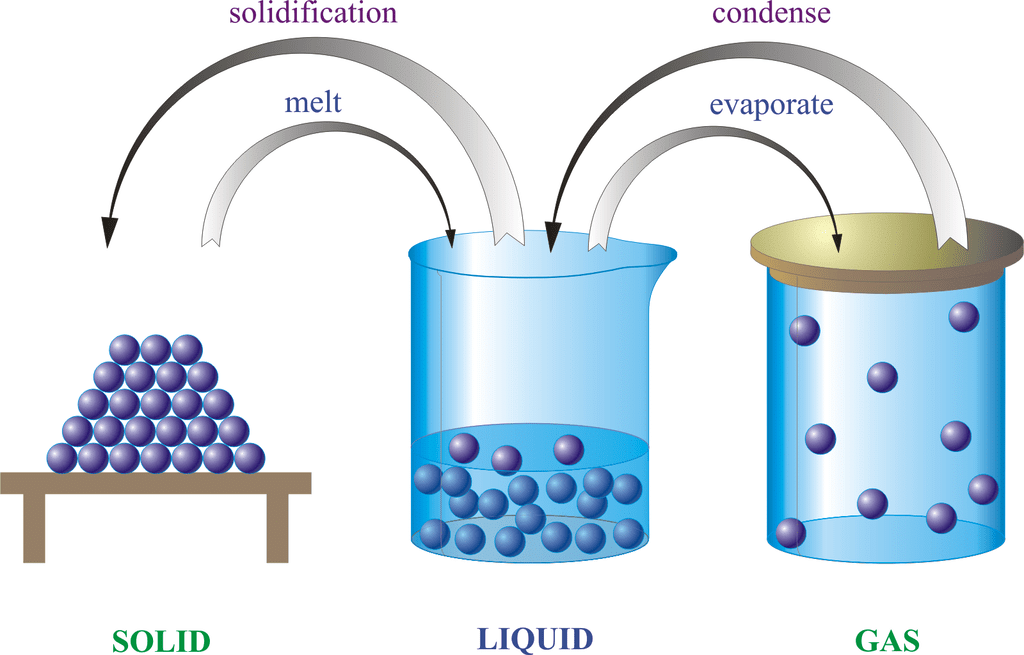 Three States of Matter
Three States of Matter
- Matter can exist in one of three main states: solid, liquid, or gas.
- Solid matter is composed of tightly packed particles. A solid will retain its shape; the particles are not free to move around.
- Liquid matter is made of more loosely packed particles. It will take the shape of its container. Particles can move about within a liquid, but they are packed densely enough that volume is maintained.
- Gaseous matter is composed of particles packed so loosely that it has neither a defined shape nor a defined volume. A gas can be compressed.
The Solid State
- Solid particles are packed closely together.
- The forces between the particles are strong enough that the particles cannot move freely; they can only vibrate.
- As a result, a solid has a stable, definite shape and a definite volume. Solids can only change shape under force, as when broken or cut.
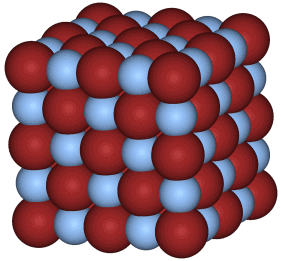 Fig: Structure of Solids
Fig: Structure of Solids
- In crystalline solids, particles are packed in a regularly ordered, repeating pattern.
- There are many different crystal structures, and the same substance can have more than one structure.
- Example: Iron has a body-centred cubic structure at temperatures below 912°C and a face-centred cubic structure between 912 and 1394°C. Ice has fifteen known crystal structures, each of which exists at a different temperature and pressure.
The Liquid State
A liquid is a fluid that conforms to the shape of its container but that retains a nearly constant volume independent of pressure.
- The volume is definite (does not change) if the temperature and pressure are constant.
- When a solid is heated above its melting point, it becomes liquid because the pressure is higher than the triple point of the substance.
- Intermolecular (or interatomic or interionic) forces are still important, but the molecules have enough energy to move around, which makes the structure mobile.
- This means that a liquid is not definite in shape but rather conforms to the shape of its container.
- Its volume is usually greater than that of its corresponding solid (water is a well-known exception to this rule).
- The highest temperature at which a particular liquid can exist is called its critical temperature.
 Fig: Structure of Liquid
Fig: Structure of Liquid
The Gaseous State
Gas molecules have either very weak bonds or no bonds at all, so they can move freely and quickly.
- Because of this, not only will a gas conform to the shape of its container, it will also expand to completely fill the container.
- Gas molecules have enough kinetic energy that the effect of intermolecular forces is small (or zero, for an ideal gas), and they are spaced very far apart from each other; the typical distance between neighbouring molecules is much greater than the size of the molecules themselves.
- A gas at a temperature below its critical temperature can also be called a vapor.
- A vapour can be liquefied through compression without cooling. It can also exist in equilibrium with a liquid (or solid), in which case the gas pressure equals the vapour pressure of the liquid (or solid).
 Fig: Structure of Gas
Fig: Structure of Gas
A supercritical fluid (SCF) is a gas whose temperature and pressure are greater than the critical temperature and critical pressure. In this state, the distinction between liquid and gas disappears. A supercritical fluid has the physical properties of a gas, but its high density lends it the properties of a solvent in some cases. This can be useful in several applications.
Example: Supercritical carbon dioxide is used to extract caffeine in the manufacturing of decaffeinated coffee.
Can Matter Change Its State?
- A substance may exist in three states of matter i.e., solid, liquid or gas, depending upon the conditions of temperature and pressure.
- By changing the conditions of temperature and pressure, all three states could be obtained (solid, liquid, gas). On heating, solid changes into a liquid, which on further heating changes into a gas.
Example: Water exists in all three states.
Solid: Ice, Liquid: Water, Gas: Water Vapour. - Ice is a solid state and may be melted to form water (liquid) which on further heating changes into steam (gas). These changes can also be reversed on cooling.
Note:
- Changing a solid to a liquid is called melting.
- Changing a liquid to solid is called solidification.
- Changing a liquid to gas is called vaporization.
- Changing a gas to liquid is called condensation.
- Changing a solid to gas directly is called sublimation.
- Changing a gas to solid directly is called deposition.
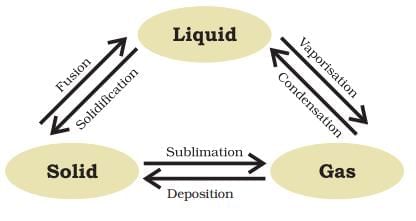
Temperature and pressure are the two factors which decide whether a given substance would be in a solid, liquid or gaseous state.
1. Effect of Change of Temperature
Let's Start with an activity
The effect of temperature on three states of matter could be seen by performing the following activity.
Procedure
(i) Take a piece of about 100 - 150 g of ice in a beaker.
(ii) Hang a thermometer in it so that its bulb is in contact with ice.
(iii) Start heating the beaker slowly on a low flame.
(iv) Note down the temperature when ice starts changing to water & ice has been converted to water.
(v) Record all observations for the conversion of solid ice into liquid water.
(vi) Now, place a glass rod in the beaker and slowly heat the beaker with constant stirring with help of a glass rod.
(vii) Note the temperature when water starts changing into water vapour.
(viii) Record all observations for the conversion of water in the liquid state to the vapour state.Observation: It is observed that as the temperature increases, the ice starts changing into water. This change is called "Melting". The temperature remains the same till all the ice changes into water. The thermometer shows 0°C until all the ice has melted. On further heating, the temperature starts rising. At 373 K (or 100°C), water starts boiling. As the water continues to boil, the temperature remains almost constant.
Conclusion of the above activity:
This experiment demonstrates that we can change the physical state of matter by heating (Solid → Liquid → Gas).
(a) Melting of Ice
- When we increase the temperature of a solid, the kinetic energy of its particles also increases. This is because the particles start to vibrate more quickly. As the kinetic energy increases, it becomes strong enough to overcome the forces of attraction holding the particles together in fixed positions.
- Eventually, the particles are able to break free from their fixed positions and start moving more freely, leading to the melting of the solid into a liquid. The melting point is the minimum temperature at which this happens, and it varies depending on the strength of the forces of attraction between the particles.
- For example, the melting point of ice is 273.15 K (or 0°C ). The process of melting, also known as fusion, occurs when a solid is heated to its melting point.
- During the melting process, the temperature of the substance remains constant, even though heat is still being supplied. This is because the heat energy is being used to overcome the forces of attraction between the particles, rather than increasing the temperature.
- The heat energy required to change 1 kg of a solid into a liquid at its melting point is called the latent heat of fusion. This energy is absorbed by the particles without causing a rise in temperature, which is why it is called latent, meaning hidden.
(b) Boiling of Water
- When we heat water at 0°C (273 K), the particles have more energy compared to those in ice at the same temperature. As we continue to supply heat to the water, the particles move even faster. Eventually, they reach a point where they have enough energy to overcome the forces of attraction between them, and the liquid starts to change into a gas.
- The temperature at which a liquid begins to boil at atmospheric pressure is called its boiling point. Boiling is a process that occurs throughout the bulk of the liquid, where particles gain enough energy to change into the vapour state. For water, this temperature is 373 K (100°C). To convert temperatures between the Kelvin and Celsius scales, we subtract 273 from the Kelvin temperature to get the Celsius temperature, and vice versa. For example, 0°C = 273 K.
- The latent heat of vaporisation is the amount of heat energy required to change 1 kg of a liquid into gas at its boiling point and atmospheric pressure. This energy is absorbed by the particles in the form of latent heat, which is why particles in steam at 373 K (100°C) have more energy than those in water at the same temperature.
(c) Sublimation
This shows that we can change the state of matter by altering the temperature. While most substances change from solid to liquid and then to gas when heated, some can change directly from solid to gas and vice versa without passing through the liquid state. This process is called sublimation when going from solid to gas, and deposition when going from gas to solid.
Lets understand Sublimation and Deposition of Camphor with an Activity
- Take some camphor and crush it into small pieces. Place the crushed camphor in a china dish. Cover the dish with an inverted funnel.
- To the stem of the funnel, place a cotton plug. This setup will help in observing the process of sublimation and deposition.
Sublimation of camphor
- Observe the camphor over time. You will notice that the camphor starts to sublimate, which means it changes from solid to gas without passing through the liquid state. The gas will then deposit on the cooler parts of the funnel, changing back into solid. This process demonstrates sublimation and deposition.
2. Effect of Change of Pressure
 By applying pressure, particles of matter can be brought close together
By applying pressure, particles of matter can be brought close together
- Solid Carbon Dioxide (Dry Ice): Solid carbon dioxide, commonly known as dry ice, is stored under high pressure. When the pressure is reduced to 1 atmosphere, dry ice sublimates directly into gas without passing through the liquid state. This phenomenon occurs because of the specific conditions of pressure and temperature.
- Influence of Pressure and Temperature: The state of a substance—whether it is a solid, liquid, or gas—is determined by the combination of pressure and temperature. By applying pressure and reducing temperature, gases can be liquefied. Conversely, changing the pressure and temperature can also lead to different states of matter.
- Gaseous State under Pressure: When pressure is applied to a gas, the particles are forced closer together. This can lead to a change in the state of matter. For example, increasing pressure on a gas while reducing temperature can cause it to liquefy.
Evaporation
- The process of a liquid changing into vapour (or gas) even below its boiling point is called evaporation
- Evaporation of a liquid can take place even at room temperature, though it is faster at higher temperatures. It is a surface phenomenon because it occurs at the surface of a liquid only. Whatever the temperature at which evaporation takes place, the latent heat of vaporisation must be supplied whenever a liquid changes into a vapour (or gas).
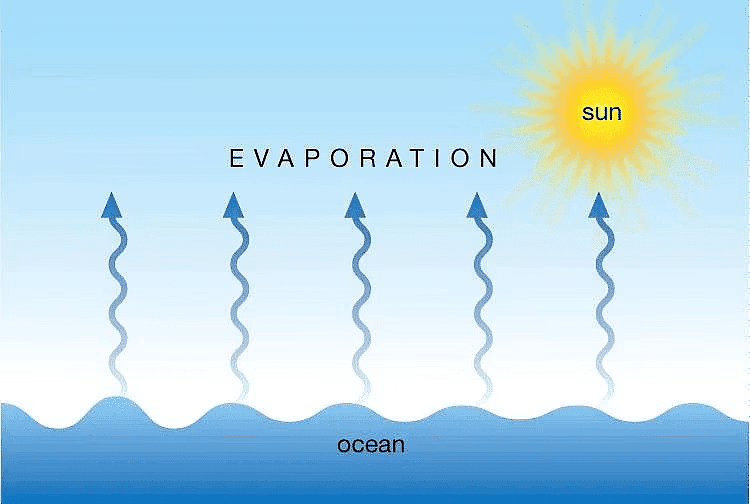 Evaporation
Evaporation
Explanation about Evaporation
- Some particles in a liquid always have more kinetic energy than others. So, even when a liquid is well below its boiling point, some of its particles have enough energy to break the forces of attraction between the particles and escape from the surface of the liquid in the form of vapour (or gas).
- Thus, the fast-moving particles (or molecules) of a liquid are constantly escaping from the liquid to form vapour (or gas).
- Examples:
(i) Water in ponds changes from liquid to vapour without reaching the boiling point.
(ii) Water, when left uncovered, slowly changes into vapours.
(iii) When we put wet clothes out to dry, the water from the clothes goes to the atmosphere.
Differences between Evaporation and Boiling
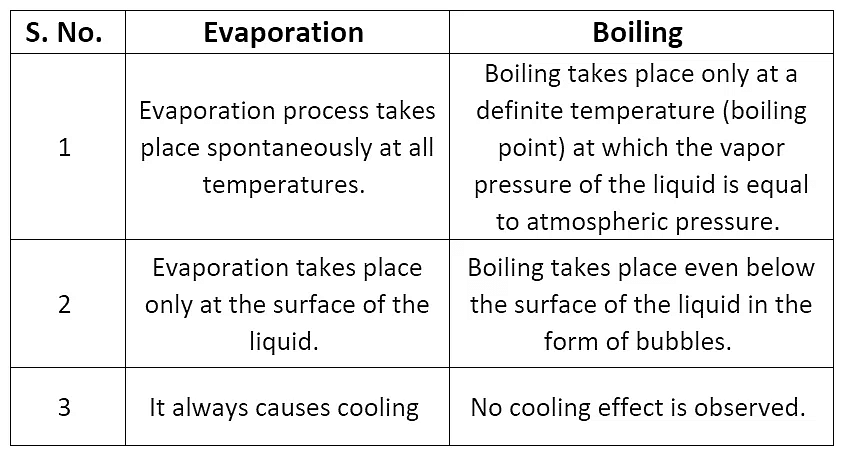
Factors Affecting Evaporation
There are five factors which affect the rate of evaporation:
1. Nature of liquid: Different liquids have different rates of evaporation. A liquid having weaker interparticle attractive forces evaporates at a faster rate because less energy is required to overcome the attractive forces.
Example: Acetone evaporates faster than water.
2. The surface area of the liquid: The evaporation depends upon the surface area. If the surface area is increased, the rate of evaporation increases because the high-energy particles from the liquid can go into the gas phase only through the surface.
Example:
(i) The rate of evaporation increases when we put kerosene or petrol in an open china dish than in a test tube.
(ii) Clothes dry faster when they are well spread because the surface area for evaporation increases.
3. Temperature: The Rate of evaporation increases with an increase in temperature. This is because with the increase in temperature number of particles gets enough kinetic energy to go into the vapour state (or gaseous state).
Example: Clothes dry faster in summer than in winter.
4. Humidity in the air: The air around us contains water vapour or moisture. The amount of water present in the air is referred to as humidity. The air cannot hold more than a definite amount of water vapour at a given temperature. If the humidity is higher, the rate of vaporisation decreases. The rate of evaporation is higher if the air is dry.
Example: Clothes do not dry easily during the rainy season because the rate of evaporation is less due to high moisture content (humidity) in the air.
5. Wind speed: The rate of evaporation also increases with an increase in the speed of the wind. This is because with an increase in the speed of wind, the particles of water vapour move away with the wind, resulting in a decrease in the amount of vapour in the atmosphere.
Example:
(i) Clothes dry faster on a windy day.
(ii) In a desert cooler, an exhaust fan sucks the moist air from the cooler chamber, which results in a greater rate of evaporation of water and hence greater cooling.
How does Evaporation cause Cooling?
- During evaporation, cooling is always caused. This is because evaporation is a phenomenon in which only the high-energy particles leave the liquid surface. As a result, the particles having low energy are left behind. Therefore, the average molecular energy of the remaining particles left in the liquid state is lowered. As a result, there is a decrease in temperature on the part of the liquid that is left. Thus, evaporation causes cooling.
- Examples:
(i) When we pour some acetone on our palm, we feel cold. This is because the particles gain energy from our palms or surroundings and leave the palm feeling cool.
(ii) We sprinkle water on the root or the open ground after a sunny, hot day. This cools the roof or open ground. This is because the large latent heat of vaporisation of water helps to cool the hot surface.
Some other examples of Evaporation
- We should wear cotton clothes in hot summer days to stay cool and comfortable: This can be explained as follows. We get a lot of sweat on our bodies on hot summer days. Cotton is a good absorber of water, so it absorbs the sweat from our body and exposes it to the air for evaporation. The evaporation of this sweat cools our body. Synthetic clothes (made of polyester, etc.) do not absorb a lot of sweat, so they fail to keep our bodies cool in summer.
- We see water droplets on the outer surface of a glass containing ice-cold water: Take some ice-cold water in a glass. Soon we will see water droplets on the outer surface of the glass.
- The water vapour present in the air, on coming in contact with the cold glass of water, loses energy and gets converted to the liquid state, which we see as water droplets.
- Water keeps cool in the earthen pot (matki) during summer: When the water oozes out of the pores of an earthen pot, during hot summer, it evaporates rapidly. As the cooling is caused by evaporation, therefore, the temperature of the water within the pot falls, and hence it becomes cool.
 Earthen Pot
Earthen Pot
- Rapid cooling of hot tea: If the tea is too hot to sip, we pour it into the saucer. In doing so, we increase the surface area and the rate of evaporation. This, in turn, causes cooling and the tea attains the desired temperature for sipping.
- A wet handkerchief is placed on the forehead of a person suffering from a high fever: The logic behind placing a wet cloth is that as the water from the wet cloth evaporates, it takes heat from the skull and the brain within it. This, in turn, lowers the temperature of the brain and protects it from any damage due to high temperature.
- We often sprinkle water on the road in summer: The water evaporates rapidly from the hot surface of the road, thereby taking heat away from it. Thus, the road becomes cool.
|
84 videos|541 docs|60 tests
|
FAQs on Matter in our surroundings Class 9 Notes Science Chapter 1
| 1. What are the main states of matter? |  |
| 2. How can matter change its state? |  |
| 3. What is latent heat and why is it called hidden heat? |  |
| 4. What factors affect the rate of evaporation? |  |
| 5. Can matter exist in multiple states at once? |  |


